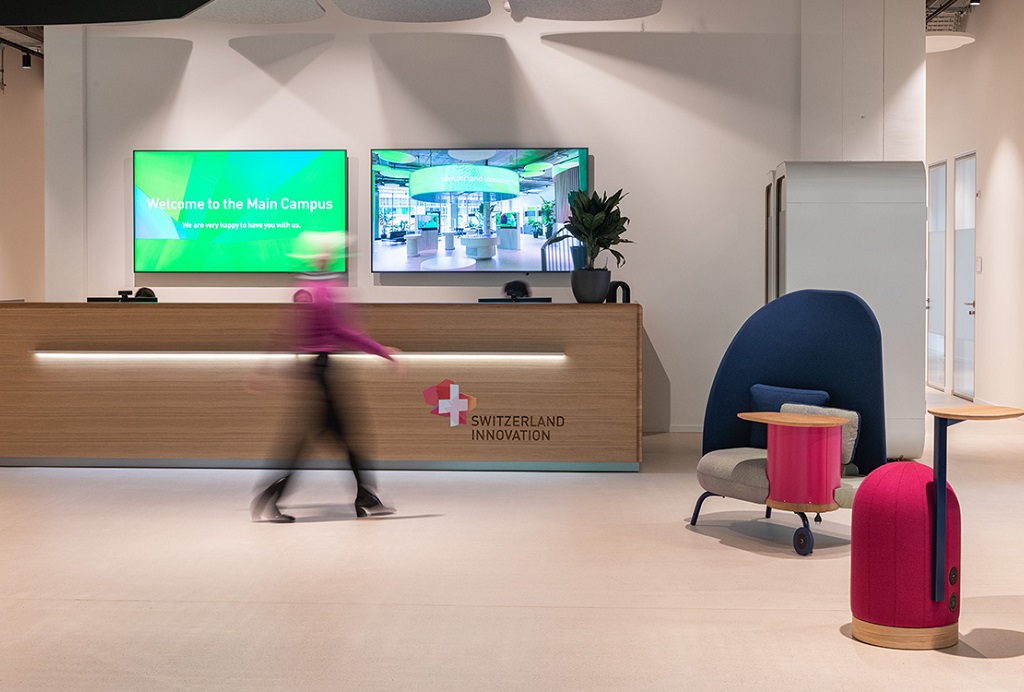As an economic powerhouse, the Basel region is known for its strong life sciences cluster; the scientific qualifications on offer there are second to none. The region is home to more than 700 life science companies that span the entire value chain. There are four locations of innovation parks in the region. These offer smaller and larger companies in the healthcare and technology sectors a platform from which to implement innovations. In collaboration with Swiss designer Björn Ischi, Girsberger Customized Furniture created the reception furniture for one of the four locations, the newly opened Main Campus in Allschwil.
A building realised according to plans by Herzog & de Meuron
In Allschwil on the outskirts of Basel, the Switzerland Innovation Park Basel Area, planned by Herzog & de Meuron, opened its doors in late October 2022. The “Main Campus” offers laboratory and office space spanning some 50,000 square metres. Around 70 % of this space has been permanently rented to companies, start-ups and the University of Basel.
Innovation today – making intelligent use of resources
The team at the Switzerland Innovation Park Basel Area wanted a few furniture as eye-catchers that would embody the spirit of innovation and could be installed in the co-working area on the new campus. As innovation today also entails the intelligent use of resources, recycling and upcycling were welcome elements in this effort.
New furniture from old waste bins
With this in mind, Swiss designer Björn Ischi created in collaboration with Girsberger Customized Furniture new mobile furniture applications, based on raw materials gleaned from old items of furniture. Specifically, metal waste bins were used here that have become obsolete in times of waste separation, vast numbers of which are still housed in furniture depots.
Agile work, thanks to an integrated power supply
Agile seating in a completely new look was created for the Smart Office of the SIP. This offered a demonstration that the use of existing, high-quality materials can be modified in a very creative and aesthetically appealing way.
The two items of furniture that emerged are forms of agile seating: a stool and an armchair with a privacy screen as a discreet visual shield. With built-in batteries and charging stations, users can charge their mobile devices directly. The furniture, in turn, draws its power from the building’s photovoltaic system.
Worksteps performed by Girsberger
After picking up the waste bins from the furniture depot, further processing began in the firm’s metal-construction facility. An angle grinder was used to re-shape the bins to the required dimensions. For the stool, the cover was screwed in place to keep the bin stable during use as seating later on. Once holes had been drilled for power connections and for subsequent fastening, the waste bins were ready for further processing in the upholstery shop.
There, the bins were clothed in coloured fabric, including a thin padding. Attaching a moveable wooden base makes the stool mobile; it lowers to the floor when sitting down. The built-in USB ports and integrated rechargeable battery provide charging for any mobile device. The wooden tray in solid oak serves both as a working table and a support for items or oneself.
Stool:
Waste bins form old depots
Metal constructions: waste bins brought to the required size with an angle grinder, covers screwed in place, holes drilled for power connections
Upholstering: padding, custom-made cover
Woodworking: manufacture of a moveable wooden base and wooden tray made of solid oak
Integration of a rechargeable battery and attaching USB ports
The armchair base frame is a plywood construction. In combination with a curved metal tube, this forms the basis of the furniture. The upholstered structure gives the armchair the seating comfort it needs. The fabric for the backrest, and for the seat and cushions, was deliberately chosen in different colours. This lends the furniture together with the coloured bin the desired pep. As the fabric used in the backrest is very flexible, it can perfectly adapt to the body’s silhouette.
Thanks to the USB ports, there are no time limits to the use of mobile devices in the armchair. In turn, the waste bin fitted into the substructure provides a housing for the rechargeable battery. The tray of solid oak tops the bin and can be used, for example, as a work surface or as another usable surface. The entire construction stands on two metal legs. Two castors are mounted on one side of these legs to give the entire armchair the needed mobility.
Armchair:
Waste bins from old depots
Metal construction: waste bin brought to the required size with an angle grinder, holes drilled for power connections, lacquered in colours, metal tube manufactured for the base frame, castors installed
Upholstering: upholstered structure on a plywood construction, cover made of custom upholstery fabric, mesh fabric for backrest attached
Woodworking: manufacture of a moveable wooden base and wooden tray made of solid oak
Integrating a rechargeable battery and attaching USB ports
Photos: Daniel Kuhn, Dorothea Scheidl-Nennemann
Sketches: Björn Ischi
About designer Björn Ischi:
Björn Ischi is an award-winning industrial and product designer. With his company, Björn Ischi | Designform, he develops new and economical design and product solutions for companies. For him, the fascination of touch and feel has a very important role to play. In his work, he goes far beyond what is generally defined as “feasibleˮ in terms of materials and function. He uses his design work in search of new solutions for the generation of tomorrow.
With his “Swiss Design Campˮ format, he created a new, interdisciplinary platform that permits students from different disciplines to collaborate on a project. He set yet another milestone for Swiss design with the “Upcycling by Designˮ brand. He takes completely new paths in product design by using existing resources and factoring aspects of sustainability into the equation – with a view towards cost-effectiveness and aesthetics.
